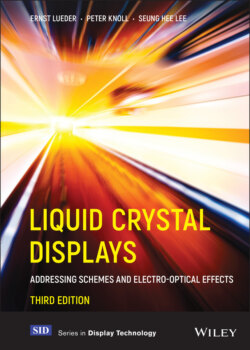Читать книгу Liquid Crystal Displays - Ernst Lueder - Страница 32
3.2.9 Fast blue phase liquid crystals
ОглавлениеThe blue phase of liquid crystals is isotropic with Δn = 0 as shown in Figure 3.28(a) (Yang et al., 2009). If a voltage V is applied between the two electrodes, the in-plane electric field E parallel to the surface of the substrates switches the LC molecules into a position tending to align parallel to E, which represents an anisotropic state with Δn ≠ 0. This is depicted in Figure 3.28(b). The transition from the isotropic to the anisotropic phase induced by E is called the Kerr effect governed by
(3.112)
where K is the Kerr constant ranging from 10−13 m/V2 to 10−8m/V2 (Kikuchi et al., 2007).
Liquid crystals exhibiting the Kerr effect are nematics or fluorinated nematics and a photo initiator monomer which are stabilized by a polymeric chiral dopant, such as ZLI-4572 by Merck (Kikuchi et al., 2009). This LC mixture is designated the polymer stabilized isotropic (PSI) mode. The cell is filled with this material at 100 °C, is UV cured and then cooled down at a rate of 1 °C/min. The LC mixture has the large Kerr constant of 10−8 m/V2. Figure 3.29 depicts a phase diagram with the two parameters, the weight fraction of the chiral dopant and the temperature. The blue phases occur in the areas designated by BP I and BP II. Below a weight fraction of 0.05 no blue phases occur. Without the chiral dopant the blue phases occurred only in a very narrow temperature range. The isotropic blue phase shows up just above the nematic- isotropic transition temperature.
The remarkable fact is the very short transition time between the two phases, which is in the range of 300 μs and below. This opens up the prospect of a very fast LC cell. In addition this cell needs neither alignment layers nor electrodes on the upper substrate, as is shown in Figures 3.28 (a) and (b).
Figure 3.28 An LC cell with (a) the isotropic blue phase when the field is off and (b) the anisotropic phase when the field is on. This figure was reproduced from Yang, Y. C. et al., SID 09, p. 586 with permission by The Society for Information Display
Figure 3.29 Phase diagram of chiral nematic LCs with blue phases BP I and BP II. This figure was reproduced from Kikuchi, H. et al., SID 09, p. 580 with permission by The Society for Information Display
Figure 3.30 Response time of the PSI-mode. This figure was reproduced from Yang, Y. C. et al., SID 09, p. 589 with permission by The Society for Information Display
Figure 3.31 Transmittance versus voltage of the PSI-mode. This figure was reproduced from Yang, Y. C. et al., SID 09, p. 588 with permission by The Society for Information Display
Figure 3.30 (Yang et al., 2009) shows the response time of the PSI-mode for a cell with a cell gap of 4 μm and a distance between the cell electrodes of 10 μm. The on/off times are 259 μs/ 258 μs, so the cell is able to handle a 240 Hz frame rate with a frame time of 4.167 ms.
Finally, Figure 3.31 depicts the transmittance of the cell versus the in-plane addressing voltage V; it exhibits a hysteresis. The weight fractions of the mixture as a percentage is LC: monomer: chiral = 68.6 : 11.6 : 19.8. The transmittance does not saturate. For useful values of a 6-17 percent transmittance, rather large voltages from 25 V to 65 V are required. Therefore a goal for further development is to lower the addressing voltage.
